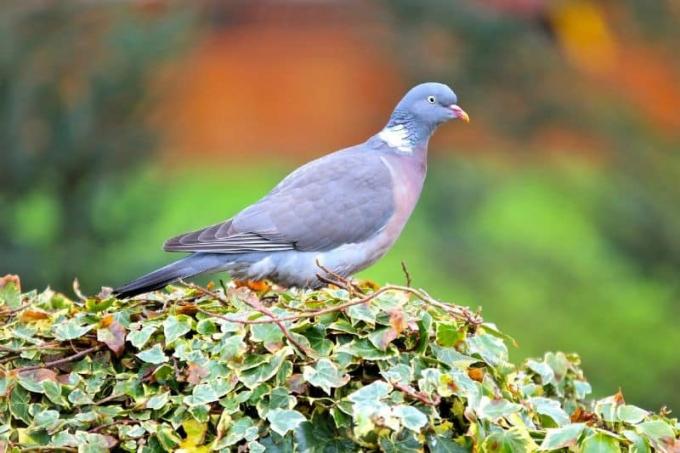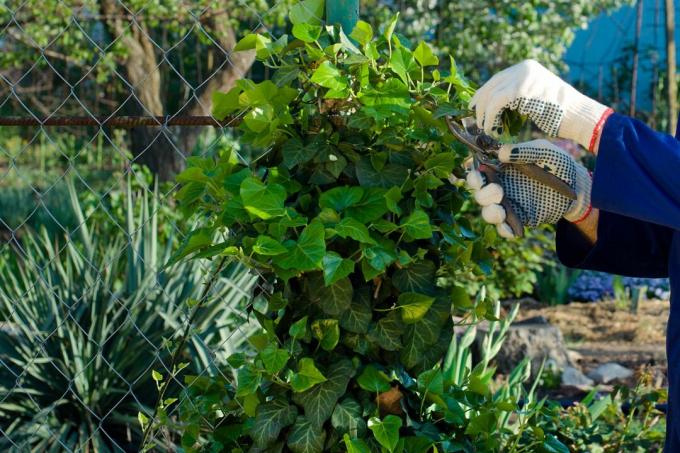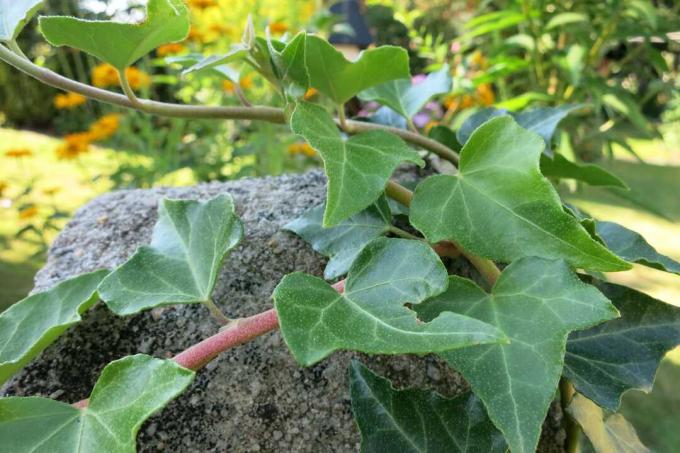
The evergreen ivy is extremely robust and easy to care for. He likes to be used for greening privacy screens and house walls. With its clinging roots, it can easily climb walls and spread itself. Ivy growth can only be curbed by cutting back.
In a nutshell
- annual growth up to 2 meters
- Section subject to Federal Nature Conservation Act
- Topiary in winter
- Remove this year's growth when trimming for summer maintenance
- radical rejuvenation is also possible
Table of contents
- Rapid growth
- Observe the Federal Nature Conservation Act
- Topiary in winter
- Care cut in summer
- Put on stick
- right tool
- frequently asked Questions
Rapid growth
Ivy (Hedera helix) is a compact growing evergreen climber. In the first few years after planting, growth is relatively slow, but then
- rapid and strong growth in width and height with increasing age
- Annual growth of up to two meters possible

As a rule, pruning measures are not absolutely necessary, only if the plant gets too big and hinders other plants. Of course, a pruning should also be done if the appearance of the climbing plant gets out of joint. There are no direct cutting techniques. The ivy quickly sprout again after each cutting measure. New shoots then cover the cut surfaces. Basically, nothing can go wrong when cutting.
A notice:Ivy is poisonous in all parts of the plant. Escaping plant sap can lead to skin irritation and blistering. Therefore, S shouldie Gloves carry. A breathing mask is also attached to prevent inhaling small parts of plants and the associated symptoms of poisoning.
Observe the Federal Nature Conservation Act
normally can ivy be cut back all year round. The best time is May and end of August. But be careful, the cutting of ivy is subject to the Federal Nature Conservation Act. The densely growing climbing plant is all too popular with birds as a breeding ground used. In this case, all comprehensive cutting measures in the period from 1 March to 30. prohibited Sept. Only slight pruning of this year's new growth is allowed during this time. However, this exemption also does not apply if the animals are disturbed in their brood care. In general, from 1 October to 28 All pruning is allowed in February, provided that wild animals are not driven away.

Topiary in winter
After a few years at the same location shows ivy how fast it can grow. A topiary can specifically limit growth:
- best time between the end of January and the end of February
- do not cut in frost
- Examine the plant for wildlife
- then cut later if necessary
- remove all long shoots
- Thin out dense ivy, e.g. all disturbingly growing shoots
- Cut out dead and diseased shoots, frost damage
- Cut back faded shoots radically
- divert them to side shoots close to the ground or walls

A notice: After 10 to 15 years, ivy no longer grows climbing, but as a compact bush. It produces greenish-yellow flowers and black, poisonous berries in autumn. Regular pruning can stimulate flowering.
Care cut in summer
The grooming cut can be done in May, better still around St. John's Day on May 24th. June to the end of July. During this time, the ivy takes a break from growth before it sprout vigorously again. The care cut is limited to this year's new growth. It should be noted
- Do not cut back on hot days and in direct sunlight
- not when birds nest in the bush
- then cut back only at the end of August
- only remove long trailing and overhanging shoots

Under no circumstances should the care cut be carried out in blazing sun. The shoots hidden under the dense foliage are uncovered. They are not used to direct sunlight and can get sunburned. Alternatively, the plant can also be suspended for a few days with a shading net.
Put on stick
If left uncut for a long period of time, ivy can become very unsightly. For rejuvenation, there is then the possibility of putting it on a stick. To do this, all tendrils are cut back completely down to the rootstock. The climbing plant survives this radical rejuvenation without any major problems. After a very short time, it drives out of the sleeping eyes again.
right tool
Cutting ivy requires the right tool. From thin branches to main shoots as thick as an arm, everything is available. The tool must be sharp. Careful cleaning and disinfection with alcohol is important before and after use. Particularly suitable are:
- for thin branches Hedge and rose shears
- small saws and pruning shears for thick branches

frequently asked Questions
Ivy loves a shady to semi-shady spot without direct sunlight, with varieties with variegated leaves preferring a little lighter. The soil must be rich in humus and nutrients, calcareous, alkaline and fresh to moist.
After planting, regular watering is required. The soil must be damp. Later, the soil must never dry out completely. The nutritional requirements are not high. Fertilization is not necessary in humus-rich soil. Compost can be added if necessary.
Propagation is by cuttings. In the period from June to early July, 15 cm long shoots are cut. These are then simply stuck in moist soil. After a short time, budding is visible.
